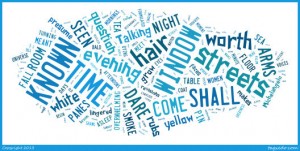A teacher friend has asked if I could do a close reading of “The Love Song of J. Alfred Prufrock”. I can’t reproduce the poem in full because it’s still in copyright in the UK, but it’s in the public domain elsewhere and you can read it here.
“Let us go then, you and I”. Seven of the most famous monosyllables in English poetry, leading us into a magical opening stanza: there’s the mystery of who’s speaking to whom; the still-disturbing image of the etherized patient; the impressionistic blur of backstreet detail.
There are also verbs.
When we first learn to write poetry it’s easy to fall into the trap of thinking it’s all about the adjectives. In the first twelve lines of “Prufrock” Eliot shows us that much of it is really about the verbs.
There are two different verb clusters in the opening stanza. The indicative active verbs are “go”, “go”, “follow”, “lead”, “ask”, “is”, “go” and “make” (I’m ignoring the modal construction “let us” because “go” is what strikes the ear). Then there are the passives and participles: “spread”, “etherized”, “deserted”, “muttering” and “overwhelming”.
In Eliot’s 1929 essay on Dante he asserted that “genuine poetry can communicate before it is understood”, and something of that is going on here. I’d love to find a group of people who’ve never read the poem to play a word association game with these two verb clusters. Ignoring the background verbs to be and to make for tidiness, what impressions do we get?
go / go / follow / lead / ask / go
spread / etherized / deserted / muttering / overwhelming
The first cluster suggests some kind of quest. The second has connotations of sickness (mental as well as physical, once you add in that “muttering”) and the ends of civilizations (to “overwhelm” is to submerge something completely, and when you put that alongside “deserted” it’s hard to avoid feeling at least mildly apocalyptic).
Quest; sickness; the end of civilization. Here is the DNA of The Waste Land embedded in the opening lines of Eliot’s first published book – written in 1910-11, a decade before the later poem. It hasn’t yet found its way to the surface (our conscious mind is still decoding Prufrock as the symbolist malaise of a New England dilettante) but it’s undeniably there. The active verbs are urging us on a quest and the passives all around us are saturated with apocalyptic sickness. That’s not what we think when we read the opening lines, but on one level it’s what we feel.
Continuing with the idea of poetry communicating before it is understood, it’s interesting to look at the prevalence of different words throughout the poem (using the reductive premise that, all else being equal, the words that occur more often are going to be the ones that leave more of an impression). Here’s what happens if you run the whole poem through a word cloud generator. If you’re new to these, the size of the words corresponds with how frequently they occur.
Again, it’s worth noting how few adjectives make it to the top of the list: “worth” is up there, and “white” and “yellow” are just about big enough to stand out, but otherwise it’s all nouns and verbs.
Everyone will see different patterns here, but I think there are some definite themes among the most prevalent words:
- words about knowing, perceiving and communicating: “known”, “seen”, “question”, “talking”;
- liminal words signalling boundaries (between things or states of being) and the temptation to cross them: “window”, “evening”, “night”, “streets”, “come”, “smoke”, “sea”;
- anatomical words: “hair”, “arms”;
- temporal words: “time”, “shall”;
- words of value: “dare”, “worth”;
- and (somewhat surprisingly) parts and contents of buildings: “floor”, “room”, “window”, “pane”, “table”.
We need to be wary of reading too much into this sort of analysis: it would be ridiculous to think a poem can be reduced to its most prevalent words in some kind of literary file-compression algorithm. Often the word that shocks or haunts us is precisely the one that doesn’t fit: most people thinking of Prufrock will remember the etherized patient or the ragged claws more vividly than a liminal semantic cluster. But if we stick with the idea of the impressions that are communicated before (or underneath, or in spite of) understanding, then the clusters above tell us something about how the poem works.
The dramatic monologues that Browning perfected in Men and Women were multi-layered psychological studies where the speaker is not always aware of their own motives, as if an entire Shakespeare play had been folded down by some multidimensional origami then pushed back out through itself in a single soliloquy. But if we read Prufrock the way we read “A Toccata of Galuppi’s” we’ll miss the point. Eliot’s narrator isn’t a character we’re meant to wrong-foot, but a consciousness (and unconsciousness) that seeps out beyond the boundaries of self and colours the external world. Streets, fog, other people – everything is filtered by, distorted by, consumed by the narrative voice. The words above are nouns and verbs – things and actions – that correlate exactly with that narrative voice’s obsessions: knowledge, time, liminal states, the body.
Eliot doesn’t need to be over-reliant on adjectives because the (soon-to-fragment) modern consciousness can appropriate all the external nouns and verbs it needs. And it’s right there in the basic diction of the poem.
As for the prevalence of buildings in our word-cloud above? A building is an archetypal image of the self: something we enter, inhabit for a while, then leave. And as we contemplate that darkest of liminal states on the other side of the door, it’s hard not to hear the eternal Footman hold our coat and snicker.


